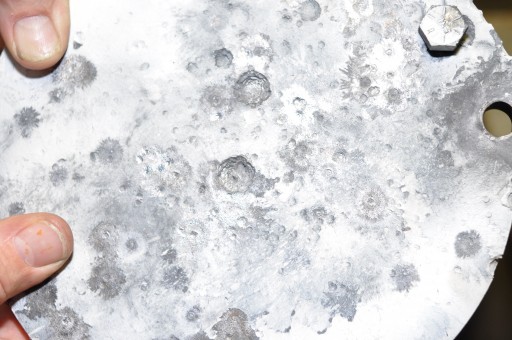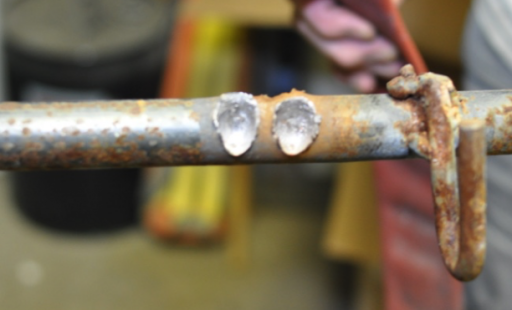A few months ago, our club started putting in gongs for members to shoot at on both the 100 yard and 200 yard rages. I thought this was a great idea, because I’m a big fan of reactive targets and getting people exiting about putting bullets on steel. But we’ve had problems with the frames getting shot up on the 100 yard gong. There have been suggestions that people are using AP ammo on the gongs. I have some experience shooting steel, but mostly with pistols and .22LR. I’m pretty sure AP will punch through 3/8 AR500 steel. Plus, AP just isn’t very common. The most common is M2 AP, and it’s not so common you’d want to target shoot with it. It’s my opinion the craters on the gong are from steel core ammo, and the small divots are from regular old 5.56x45mm. The gong is made of AR500 steel, 3/8″ thick.
The frame holding the gongs up is mild steel bar, about 1/2 inch, and took this damage:
I asked Joe Huffman, who has a lot more experience with this kind of thing than I do what the damage looked like to him, and he was kind enough to run an experiment. Sure enough, regular old .223 rounds will shoot right through mild steel, while pistol ammunition will just polish it. Looks to me like these are rifle hits, with just ordinary ammunition. I’m thinking we may want to acquire one of these armored stands from Salute Targets. We expected this to be a maintenance items, but so are wooden target frames, and people like to shoot the gongs. There’s also speculation among club leadership that some of the damage is deliberate. I’ll admit the tight group on the bar right where the straps were is suspicious, but I’d hate to see someone brought up on charges and booted from the club for poor marksmanship. I’m also thinking we might need to ask members not to shoot at the gongs with steel core ammunition.
If anyone else can offer their experience, I’d be appreciative.



Regarding the gong, velocity is apparently a HUGE factor when it comes to damage to steel plates. The little divots look like what M855 and 7n6 does to my plates at 100yrds, and rounds like .204 Ruger do more (even with light weight thin jacketed varmint bullets), but not as much as the big craters. I might suspect 22-250 or maybe all copper bullets?
I think you’ll want to use at least 1/2″ thick AR500 for rifle shooting. Thicker would be better for heavy use. Our gongs are hung on a very large frame to reduce strikes from poorly aimed shots. The steel is suspended using strips of conveyor belt. Some people suspect our shooters intentionally shoot the stove bolts on purpose, but watching the average shooter, it could only be on accident.
We don’t allow steel core ammo on our range. The risk of fire and ricochets is too high in our area. The long range group I shoot with requires varmint or open tipped rifle ammo.
“The steel is suspended using strips of conveyor belt.”
Old/decommissioned fire hose works really well too.
That’s what we’re using now.
MGM targets are somewhat expensive but they are very well made.
It is gonna sound silly, but cover the bars and any structure with pressure treated 2x4s. It will reduce both damage and ricochets plus cheaper to replace.
And careful about the steel core thing. Russian ammo uses a very soft steel core that do not damage the gongs but it gets banned anyway and pisses people off.
Are they really divots ? Not some lead build-up ?
I would hit up GT Targets, which is sort of down in your part of the state, about replacement targets. Karl McKeever is great to deal with and his steel is the only steel used in the PA steel league and many PA 3Gun matches.
On the plus side it a fairly nice looking moonscape you got there!
I had a friend who got some steel plates from a destroyer being scrapped, about 3/8 inch steel, 270 win punched nice clean holes thru it that looked drilled.
We only used them for pistol rounds after that.
The stands we put up for hanging gongs at my club were cut and notched pieces of railroad track, not railroad ties but the steel track. There were a couple long upright pieces that went into the ground and notched for a cross-bar – and boy was that heavy! Took a group effort. Somebody knew someone at Southern Pacific.
You might contact MGM targets about this and see what they suggest. Their FAQ suggests 150 yards for most steel with 7.62 and 5.56, http://mgmtargets.com/faqs#rifle
But I bet you could get some more detailed ideas if you contact them.
You may be making a false assumption that people actually know they are using steel core ammo. I have many boxes of .308 I’ve picked up over the years and never got around to shooting. I would have to read the boxes carefully to tell.
A magnet is a much quicker way to check. Maybe hang some magnets on the range and ask people to check their ammo before shooting the steel? That’s what 3 gun matches do.
Also +1 for Karl at GT Targets. He’s a good guy and you can save a lot of shipping cost by picking up since he’s relatively local.
Of course alot of norinco and russian ammo is mild steel jacketed and lead filled too, so a magnet will stick to them but they aren’t penetrating rounds.
Definitely go with ½†for targets. I think a lot of the problem is the majority of these companies that make steel targets just decided to go into the target making business without truly understanding how to properly handle the steel and harden it. One company I will swear by is http://metaltargets.com/ They really seem to know what they are doing and their targets last. They seem to have less weak spots than other companies I have seen. How every they handle/cut the steel they know what they are doing. As for the target stand I have less experience with the hardened ones. I know if you are trying to do it cheap though and make it so you can replace certain parts cheap galvanized pipe with a thread tool and elbows can go a long way. If you need to replaced one part you just do it.
I agree with your points but would suggest people not pay for expensive consumable items that you are going to shoot with high-velocity ammunition. M855 on 1/2 inch will still divot the target.
If you are shooting .308, then you should definitely have more mass in the plate. But for 5.56 it won’t matter. We shoot 8″ plates at 50 yards and they survive many rounds. At least until something like M855 comes out (or even AP 5.7×28).
Price being almost equal, definitely go with a heavier plate if you are willing to handle them. But if the price for the “premium” thickness is a lot more, it won’t help the problem above if people are still shooting steel ammo.
Again: consumables.
Those divets are almost surely from M855 or similar. I can tell you with conviction that non-steel 5.56 at under 50 yards won’t leave such marks, except occasionally along the edges or in areas where repeated heat treating (read: weld repairs) lowers the hardness of the steel in the heat affected zone. I have also seen com-bloc 7.62×39 do the same, but with less regularity. You cannot rely on a spark to tell whether alloys is hitting your steel. It’s hit or miss.
I make 3/8″ AR500 targets for personal use – start with a large plate and turn into smaller plates with a plasma torch. For me, the 1/2 inch is not worth the extra weight in handling the large plates before cutting (I am a one-man team when I work it and not a Norse God). The 3/8ths lasts a good time.
I say don’t bother the people who sold you the targets unless it is to buy more. It’s quiet 9 out of 10 days around here. Still they get chewed up a little more every time the rifles come out. They are consumables.
Making your own is not suggested, either. You won’t save any money unless you already have the equipment, and welding abrasion resistance plate is a little more more involved than welding mild steel (not by a lot, but just enough that getting it wrong means you wasted time and material that cannot be fixed).
As for frames, just use wood for the whole thing. Cheap and easy to replace. We made three frames in about 20 minutes last month. They last a few thousand rounds, and the guests think it’s funny to watch the riser get shorter every time we shoot. They start at five foot and basically hit the ground before we replace them.
I’ve shot quite a few steel plates and in my experience velocity has more to do with steel penetration than bullet construction.
My 22-250 will punch holes in 3/8 inch steel plate with 53 grain hollow point varmint bullets. Speed 3700 fps+. The steel shows a crater on _both_ sides of the hole.
My 45-70 shooting a 400 grain bullet will almost blow the plate off the base, but won’t penetrate. Velocity around 2100 fps.
My guess would be any projectile moving at over 3000 fps will put a hole in most steel plates of 1/4 to 3/8 inch thickness. While a steel “penetration” core may have some effect, I’d bet on velocity being more important.
my experience with AR500 is that pistol rounds do no damage, 7.62×39 does no damage out of a 16″ barrel at 50 yards, and non-steel 5.56 out of a 20″ barrel will pit the metal at 100 yards. that’s the reason for a 20″ barrel, but its hard on a target!
The divots may be from pistol caliber bullets from a carbine. I destroyed a spinner that way with a .357 lever. In my experience rifle rounds just punch clean holes right through unless it’s something really slow like .45-70 ‘cowboy’ loads (trail boss).
That would be true of mild steel targets. This is a hardened steel. Pistol rounds just polish the surface a bit. I tried out my .223 55gr FMJ ounds at 200 yards yesterday on the other gong, and it didn’t do much either.